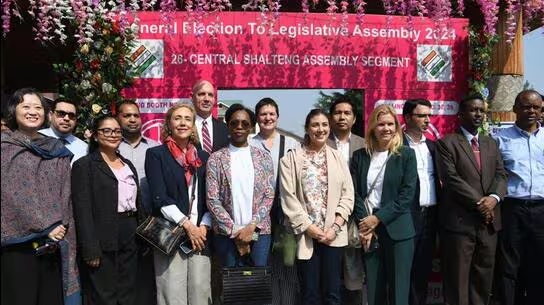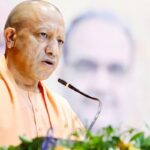For the first time in recent years, the government has arranged for foreign diplomats to visit the Kashmir Valley and observe the election process.

Voters in 26 constituencies across six districts of the union territory headed to the polls on Wednesday.
Key Highlights:
- Historic Diplomatic Visit: Foreign diplomats from 15 nations visit Kashmir for the first time in recent years to witness polling.
- Strategic Representation: The delegation includes representatives from major global powers like the U.S. and UN Security Council members.
- Security Concerns: Diplomats toured polling stations amid heightened security due to recent terror attacks in the region.
- Second Phase of Elections: The diplomats observed polling in 26 constituencies, with high-profile candidates in the running.
For the first time in recent years, the Indian government has organized a high-profile visit by foreign diplomats to Kashmir, allowing them to observe the ongoing election process. Diplomats from 15 countries, including the United States, Singapore, South Korea, and South Africa, visited the region on Wednesday to witness the second phase of polling in the union territory of Jammu and Kashmir.
The delegation, featuring notable figures like U.S. Chargé d’Affaires Jorgan Andrews, South Korea’s Deputy Chief of Mission Lim Sang Woo, and Singapore’s Deputy High Commissioner Alice Cheng, toured polling stations across Srinagar and Budgam, according to sources familiar with the event.
This significant visit comes after the Indian government revoked Jammu and Kashmir’s special status and bifurcated it into two union territories in 2019. While diplomats and European Parliament members had been invited in the past, this marks the first election-monitoring trip for foreign officials in recent years.
Countries participating in the day-long visit, organized by the Ministry of External Affairs, included the U.S., Singapore, South Korea, South Africa, Norway, the Philippines, Spain, Algeria, Guyana, Mexico, Nigeria, Panama, Rwanda, Somalia, and Tanzania. The diplomats were mostly deputy chiefs of mission or chargé d’affaires, with some represented by political officers or counselors. Senior Indian officials, such as JP Singh, Joint Secretary for the Pakistan-Afghanistan-Iran desk, accompanied the group.
Sources revealed that the selection of countries was strategic, ensuring representation from the United Nations Security Council’s P-5 members and diverse geographic regions. Security was a key concern given recent terrorist attacks in the Jammu region, prompting the government to limit the size of the group.
“The idea was to have a diverse group for a first-hand assessment of the ground situation, but the group had to remain small due to security constraints,” one official commented. The diplomats visited polling stations in key areas like Ompura (Budgam), Bemina, Amira Kadal, SP College, and Chinar Bagh (Srinagar), part of the Lal Chowk constituency. At SP College, they toured a special “pink polling station” staffed entirely by women.
Twenty-six constituencies across six districts voted on Wednesday, with prominent candidates such as former Chief Minister Omar Abdullah and BJP leader Ravinder Raina in the fray. The first phase of polling on September 18 recorded an impressive turnout of over 61%.
During media interactions, Singapore’s Alice Cheng expressed gratitude to the Indian government for organizing the visit, while South Korea’s Lim Sang Woo praised the “vibrant enthusiasm” of voters, remarking, “This is democracy in action.”
Some countries declined the invitation to participate in the visit, citing short notice and lack of a detailed itinerary. However, the government is planning a second trip for diplomats to observe the third phase of polling on October 1.











